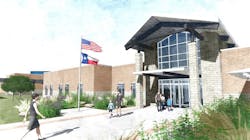Primary school campus in Wimberley, Texas, will significantly cut potable water use
The Wimberley (Texas) school district is scheduled to break ground later this month on a school campus designed to drastically reduce groundwater use.
The school, which will serve students from prekindergarten to second grade, will be the first “One Water” campus in Texas, the district says. One Water, according to the Texas Living Waters Project, is a collaborative water planning and operational approach that uses diverse and connected strategies to manage limited water resources.
The campus will incorporate rainwater and HVAC condensate collection together with wastewater treatment and reuse. The system is expected to reduce potable water use on campus by as much as 90%.
"We're excited to get this project underway, and are really looking forward to that first-day of school experience for all our younger students at this spacious, state-of-the art, green campus, in a little over a year from now," says Wimberley Superintendent Dwain York.
The $31.3 million school will have about 90,600 square feet of space and will accommodate about 800 students. It is slated to open in summer 2020, The San Marcos Record reports.
“It is historic,” says Nick Dornak with the Cypress Creek Watershed Protection Plan. “There are no schools in Texas that incorporate all of these different water conservation and water quality protection features.”
The intent is to handle both water and wastewater in the most environmentally friendly way possible.
From a water reuse stand point, rainwater is collected from the roof and runs through clear pipes throughout the building in order to be a visual teaching aid for students. That water, along with collection from the HVAC units, will be used to flush the toilets in the school.
Wastewater will be collected and treated onsite. The treated effluent will be used for irrigation throughout the grounds of the school including for a field on the property. Storm water will be collected and filter in rainwater gardens.
“Water is precious around this area,” York says. “We felt a responsibility to try and do something like this.”
York says the costs for construction of the One Water sewage system are comparable to what the costs would have been for more traditional methods of wastewater treatment.
In the end, it is a project that many hope will be a game changer when it comes to reusing water.
“It shows that this type of work can be done and will be done and will have tremendous benefits for the valley,” Dornak says. “It will be our proving ground for One Water. The implications are large in terms of how the ripple effect might be able to take hold throughout the Hill Country.”
About the Author
Mike Kennedy
Senior Editor
Mike Kennedy, senior editor, has written for AS&U on a wide range of educational issues since 1999.
